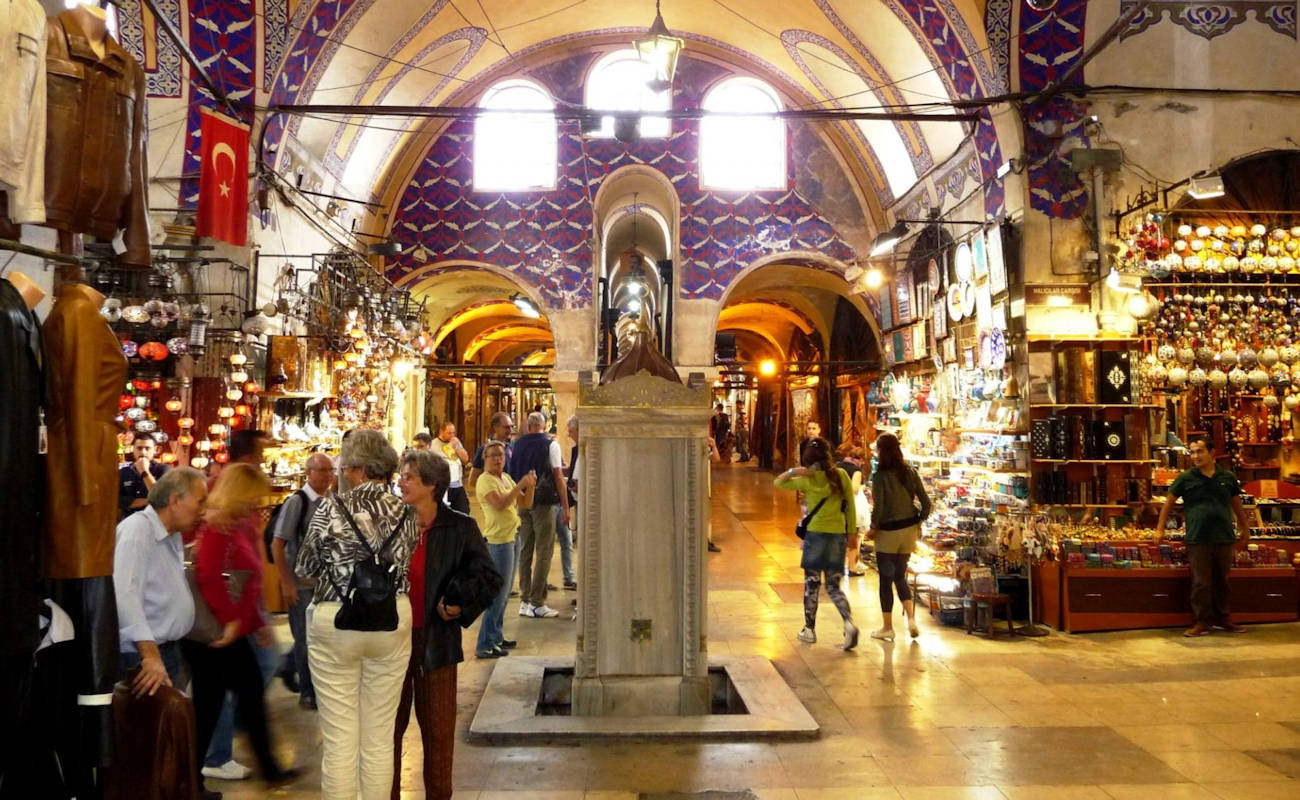
Grand Bazaar Istanbul
The Grand Bazaar Istanbul (Turkish: Kapalicarsi, meaning “Covered Market”; also Büyük Çarşı, meaning “Grand Market”) in Istanbul is one of the largest and oldest covered markets in the world, with 61 covered streets and over 4,000 shops on a total area of 30,700 m2, attracting between 250,000 and 400,000 visitors daily. In 2014, it was ranked #1 of the world’s most visited tourist attractions with 91,250,000 annual visitors The Grand Bazaar of Istanbul is often considered to be one of the world’s first shopping malls.
Grand Bazaar History
Construction of the core of the future Grand Bazaar began in the winter of 1455/56, shortly after the Ottoman conquest of Constantinople, as part of a wider initiative to stimulate economic prosperity in Istanbul. Sultan Mehmed II had a building built near his palace in Constantinople for the trade in textiles and jewels, which was called Cevâhir Bedestan (“Bedesten of Gems”) and was also known in Ottoman Turkish as Bezzâzistan-ı Cedîd (“New Bedesten”).
The word Bedesten comes from the Persian word bezestan, derived from bez (“cloth”), and means “bazaar of cloth sellers.” The building – alternately called İç (“Inner”), Antik (“Ancient”) or Eski (“Old”) Bedesten in Turkish – is located on the slope of Istanbul’s third hill, between the ancient Fora of Constantine and Theodosius. It was also close to the first Sultan’s palace, the Old Palace (Eski Saray), which was also built in the same years, and not far from Artopoleia (in Greek) (Άρτοπωλεία), the city’s bakers’ quarter in Byzantine times.
The construction of the Bedesten was completed in the winter of 1460/61 and the building was donated to the Waqf of the Hagia Sophia Mosque. Analysis of the masonry shows that most of the structure dates from the second half of the 15th century, although a Byzantine relief depicting a Comnenian eagle, which is still preserved at the top of the eastern gate (Kuyumcular Kapısı) of the Bedesten, has been used by several scholars as evidence that the building was a Byzantine structure.
A market near the Bedesten, called Esir Pazarı in Turkish, was active in the slave trade, a use also inherited from Byzantine times. Other important markets in the area were the second-hand market (Turkish: Bit Pazarı), the “Long Market” (Uzun Çarşı), corresponding to the Greek Makros Embolos (Μακρός Ὲμβολος, “Long Portico”), a long porticoed mall stretching from the Forum of Constantine down to the Golden Horn, which was one of the main market areas of the city, while the Old Book Market (Sahaflar Çarşısı) was moved from the Bazaar to its present picturesque location near the Beyazid Mosque only after the Istanbul earthquake of 1894.
Some years later, according to other sources, in 1545 under Sultan Suleyman I, Mehmed II had another covered market built, the “Sandal Bedesten” (the name comes from a type of thread woven in Bursa that had the colour of sandalwood), also called Küçük (“Little”), Cedit or Yeni (both words meaning “New”) Bedesten, which was located north of the first.
After the construction of the Sandal Bedesten, the trade in textiles moved there, while the Cevahir Bedesten was reserved for the trade in luxury goods. Initially, the two buildings were isolated from each other. According to the 16th-century French traveller Pierre Gilles, between them and the Beyazid Mosque stood the ruins of churches and a large cistern, but soon many merchants opened shops between and around them, creating an entire quarter devoted exclusively to commerce.
By the beginning of the 17th century, the Grand Bazaar had already taken its final shape. The sheer size of the Ottoman Empire, spanning three continents, and its total control of road communications between Asia and Europe, made the bazaar and the surrounding hans, or caravanserais, the hub of Mediterranean trade.
According to several European travellers, at that time and until the first half of the 19th century, the market was unrivalled in Europe in terms of the abundance, variety and quality of the goods on sale. At that time, European travellers told us that the Grand Bazaar had a square layout, with two perpendicular main streets crossing in the middle and a third street running along the outer perimeter.
There were 67 streets in the bazaar (each bearing the name of the seller of a particular commodity), several squares used for daily prayers, 5 mosques, 7 fountains, 18 gates which were opened every day in the morning and closed in the evening Around 1638 the Turkish traveller Evliya Çelebi gave us the most important historical description of the bazaar and its customs.
The number of shops was 3,000, plus 300 in the surrounding hans, large caravanserais of two or three storeys around a porticoed inner courtyard, where goods could be stored and merchants could be housed At that time, a tenth of the city’s shops were concentrated in and around the market.
The Grand Bazaar was subject to repeated disasters, fires and earthquakes. The first fire occurred in 1515, another in 1548, and other fires ravaged the complex in 1588, 1618 (when Bit Pazarı was destroyed), 1645, 1652, 1658, 1660 (when the whole city was devastated), 1687, 1688 (when Uzun Çarşı was badly damaged), 1695 and 1701. The fire of 1701 was particularly severe and forced Grand Vizier Nevşehirli Damad Ibrahim Pasha to rebuild several parts of the complex in 1730-1731. In 1738, Kızlar Ağası Beşir Ağa donated the fountain (which still exists) near Mercan Kapı.
During this period, several parts of the market between the two Bedesten were covered with vaults due to the new law against fires of 1696. Nevertheless, further fires ravaged the complex in 1750 and 1791. The earthquake of 1766 caused further damage, which was repaired a year later by the court architect (Hassa Baş Mimarı) Ahmet.
The growth of the textile industry in Western Europe in the 19th century, the introduction of mass production methods, the capitulations signed between the Ottoman Empire and many European countries, and the anticipation – always by European merchants – of the raw materials needed to produce goods in the closed economy of the Ottoman Empire were factors that caused the decline of the market.
In 1850, the rents in the Bazaar were ten times lower than they had been two or three decades before Moreover, the emergence of a westernised bourgeoisie and the commercial success of western products led minority merchants (Greeks, Armenians, Jews) to leave the Bazaar, which was perceived as antiquated, and open new shops in districts frequented by Europeans, such as Pera and Galata.
According to an 1890 survey, the bazaar had 4,399 active shops, 2 bedesten, 2195 rooms, 1 hamam, 1 mosque, 10 medrese, 19 fountains (including two şadırvan and one sebil), 1 mausoleum and 24 han. In the 30.7 hectares of the complex, protected by 18 gates, there are 3,000 shops in 61 streets, the 2 bedesten, 13 han (plus several more outside).
The last major disaster occurred in 1894, when a violent earthquake shook Istanbul, and the Minister of Public Works, Mahmud Celaleddin Pasha, oversaw the repair of the damaged bazaar until 1898, when the complex was reduced in size. To the west, Bit Pazarı was left outside the new perimeter and became an open street called Çadırcılar Caddesi (“Tentmaker Street”), while the old gate and Kütkculer Kapi were demolished. Of all the hans that belonged to the market, many were left outside and only nine remained inside the building.
In 1914, the Sandal Bedesten, whose textile traders had been ruined by European competition, was bought by the Istanbul Municipality and used as an auction house, mainly for carpets, from the following year. In 1927, the different parts of the bazaar and the streets were given official names. The last fires of the Bazaar took place in 1943 and 1954, and the restoration work was completed on 28 July 1959.
The last restoration of the complex took place in 1980. On this occasion, the advertising posters around the market were also removed.
Architecture
Iç Bedesten has a rectangular ground plan (43.30 m x 29.50 m). Two rows of stone pillars, four in each row, support three rows of bays, five in each row. Each bay is surmounted by a brick dome with a blind drum. There are 44 cellars (Turkish: mahzen), vaulted rooms without external openings, built into the inner and outer walls.
The sunlight in Bedesten comes from rectangular windows placed directly under the roof: they can be accessed through a wooden staircase. Due to the lack of lighting, the building was only open for a few hours a day and was dedicated to the trade of luxury goods, especially textiles. The mahzes of the Bedesten were also used as safes. The building is accessed through four gates:
“Second-hand Booksellers’ Gate” (Sahaflar Kapısı) in the north,
“Skullcap Gate (Takkeciler Kapısı) in the south,
“Jeweller’s Gate (Kuyumcular Kapısı) in the east and;
“Women’s Clothiers’ Gate” (Zenneciler Kapısı) in the west.
The Sandal Bedesten also has a rectangular plan (40.20 m × 42.20 m), with 12 stone piers supporting 20 bays, topped by brick domes with blind drums. In this case, the shops are only carved into the outer walls. In both buildings, each bay is connected to the others by brick arches connected by juniper beams, and the masonry is made of rubble. Both buildings were closed by iron gates.
Apart from the bays, the structures of the Grand Bazaar were originally built of wood, and only after the fire of 1700 were they rebuilt in stone and masonry and covered. All the bazaar buildings, except the Fur Traders’ Market (Turkish: Kürkçüler Çarsısı), a later addition, which is two-storey, are single-storey. The roofs are mainly tiled, while the part that was burnt in 1954 now uses asphalt. The bazaar had no artificial lighting, partly to prevent fires, and smoking was strictly forbidden.
The streets outside the inner bazaar run roughly parallel to it. The damage caused by the many fires and earthquakes over the centuries, together with the repairs made without a general plan, have given the bazaar a picturesque appearance, especially in its western part, with its maze of streets and alleys crossing each other at different angles.
